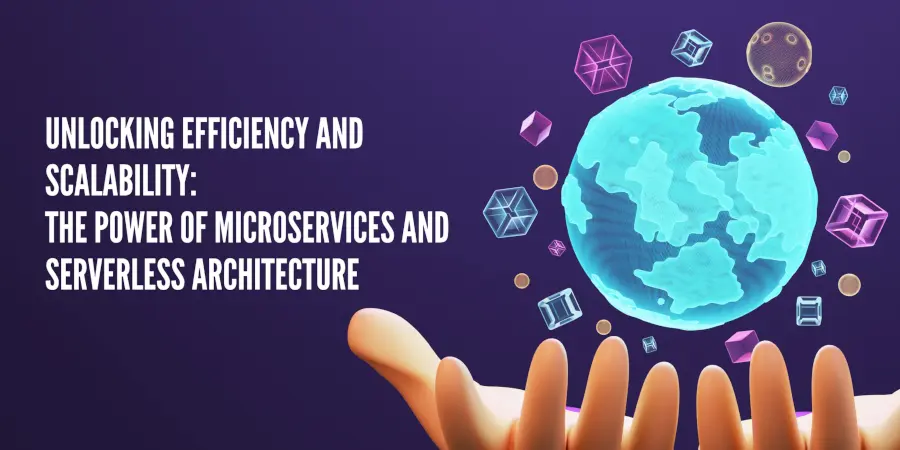In today’s fast-paced and highly competitive business landscape, efficiency and scalability have become paramount for organizations aiming to stay ahead of the curve. Traditional monolithic architectures are often unable to keep up with the evolving demands of modern businesses, leading to bottlenecks, limited flexibility, and higher operational costs. This is where the power of microservices and serverless architecture comes into play.
Microservices and serverless architecture are two innovative approaches that have revolutionized the way applications are designed, developed, and deployed. By breaking down complex systems into smaller, independent components and leveraging cloud computing capabilities, these architectural paradigms enable businesses to unlock new levels of agility, scalability, and cost optimization.
In this article, we will discuss microservices and serverless architecture, exploring their definitions, characteristics, and the significant advantages they offer to businesses. We will also discuss the challenges associated with these approaches and provide real-world examples of successful implementations.
By understanding the synergy between microservices and serverless architecture, businesses can harness the full potential of these technologies to create efficient, scalable, and robust systems. Or, at least, garner an understanding as to why others are doing it.
So, let’s unravel some of the intricacies of microservices and serverless architecture, and discover how they can drive your business towards a more streamlined and future-proof approach to software development and deployment.
- Understanding Microservices
- Exploring Serverless Architecture
- Leveraging the Synergy: Microservices and Serverless Architecture
- Conclusion
Understanding Microservices
Microservices have been compared to superheroes. No joke. Specifically regarding the design and development of application architecture. They help break down complex applications into smaller, autonomous services that work together to save the day and the project timeline. Let’s get into the world of microservices, take the time to understand what they are, what makes them tick, and why businesses love them.
So, what exactly are microservices? Think of them as tiny, self-contained services, each responsible for a specific task or functionality in an application. Another term that has been attributed to this idea is modules. A complex ecosystem of tasks can be reflected by a series, or collection, of smaller tasks and goals. These services operate independently, with their own code, databases, and ways of talking to each other to collectively make up the user experience.
Let’s take a closer look at the key characteristics of microservices:
- Modularity and Scalability: Microservices are all about being modular. They allow you to divide your application into smaller, manageable chunks. Each microservice focuses on a specific business capability or feature. This modularity makes it easier to scale individual services based on their specific needs, without having to scale the entire application. For example, if your application experiences a surge in user activity on a particular feature, you can scale only the microservice responsible for that feature, ensuring optimal resource allocation and performance.
- Independent Development and Deployment: One of the coolest things about microservices is that you can work on them independently. This means different teams can focus on different services simultaneously, without stepping on each other’s toes. It speeds up development, encourages innovation, and gets new features out the door faster. Plus, you can deploy each microservice independently, without disrupting the whole system. This agility allows businesses to iterate and release updates more frequently, respond to market demands quickly, and experiment with new ideas. It’s like building a puzzle where each piece can be placed individually, enabling faster progress.
- Fault Isolation and Resilience: Microservices are resilient like a superhero who never gives up. Since each service operates independently, if one service fails, it doesn’t bring down the entire application. Failures are contained within the affected service, while the rest of the system continues to function smoothly. This fault isolation ensures that issues in one microservice don’t cascade and impact the overall application’s stability. Additionally, microservices can implement strategies like circuit breakers and retries to handle failures gracefully and recover from errors swiftly. It’s like having a team of heroes where even if one falls, the others are there to save the day, ensuring uninterrupted service availability.
While microservices bring a lot of advantages to the table, they do come with their own set of challenges. As it has been said, there is no perfect. Some of the obstacles that must be confronted are:
- Distributed Complexity: With great power comes great complexity. Coordinating communication and data consistency between microservices can get tricky. Since microservices operate independently, they need to communicate with each other effectively to exchange information and collaborate. This requires careful planning, well-defined protocols, and design patterns to ensure everything works together seamlessly. Monitoring and troubleshooting a distributed system can also be more challenging than with monolithic architectures. However, with proper architectural design and the right tools, the benefits outweigh the complexities.
- Data Management and Consistency: When you have multiple microservices working independently, ensuring data consistency across the board can be a challenge. Each microservice may have its own data storage, and maintaining data consistency and integrity across these services requires thoughtful design and implementation. Strategies like distributed transactions or eventual consistency models can be employed, depending on the specific requirements of the application. Data duplication and synchronization between services may introduce additional complexities and potential points of failure. However, with careful planning and the right data management strategies, these challenges can be overcome.
- Inter-Service Communication: Microservices need to talk to each other effectively. They rely on lightweight protocols like REST (Representational State Transfer) or messaging systems like RabbitMQ or Kafka to facilitate communication between services. Proper handling of network latency, timeouts, and failure scenarios is crucial to ensure reliable communication. This requires understanding the trade-offs between synchronous and asynchronous communication patterns and choosing the most suitable approach for each interaction. It’s like ensuring that heroes can communicate with each other quickly and efficiently, passing along vital information to save the day.
Now that we have a basic understanding of the ins and outs of microservices, we can shift our focus to how they relate to serverless architecture.

Exploring Serverless Architecture
Serverless architecture is like having your own team of invisible assistants who handle all the backend work without you having to worry about servers or infrastructure. Simply put, serverless architecture is an approach to back-end development where the cloud services provider takes care of all the underlying infrastructure management, allowing developers to focus solely on writing code for their applications. Meaning the normal development resources that would be dedicated to ensuring operational excellence regarding scalability, data lakes, and more are outsourced.
Here are some key characteristics of serverless architecture:
- Event-Driven and Function as a Service (FaaS): Serverless architecture operates on the principle of event-driven computing, where functions are triggered by specific events or requests. Developers write functions (also known as serverless functions or lambda functions) that are executed in response to events. The cloud provider manages the infrastructure needed to run these functions, automatically scaling them based on demand.
- Cost-Effectiveness and Scalability: With serverless architecture, you only pay for the actual execution time of your functions, rather than for maintaining idle server resources. This pay-as-you-go model makes it cost-effective, especially for applications with varying or unpredictable workloads. Serverless architecture also offers automatic scaling, ensuring that functions scale up or down based on the incoming workload, providing high scalability without the need for manual intervention.
- Reduced Operational Overhead: By offloading infrastructure management to the cloud provider, serverless architecture reduces the operational burden on development teams. You don’t have to worry about server provisioning, capacity planning, or managing infrastructure scaling. This allows developers to focus more on writing code and delivering value to their customers.
Well, that’s all well and good, but what are the benefits that could be gained should a company wish to adopt that serverless architecture life? In short, serverless architecture brings several advantages to the table, all of which are listed as the key characteristics:
- Cost-Effectiveness and Scalability: For the same reasons as listed above. Typically, proponents tend to tout this option as favorable for situations that don’t have the luxury of completely known traffic and data usage rates. This model tends to fall into what is considered a consumption-based approach or Pay-as-you-go pricing. With serverless architecture, you only pay for the actual execution time of your functions, making it cost-effective, especially for applications with varying workloads.
- Automatic Scaling and Resource Allocation: Functions automatically scale up or down based on the incoming workload, ensuring optimal resource allocation and cost efficiency. This allows for elasticity within the ecosystem. Serverless platforms handle the scaling of functions as needed, ensuring that resources are dynamically allocated to match the workload. This allows applications to handle sudden traffic spikes without any performance degradation. This makes resource optimization a little simpler, as well. You don’t have to worry about overprovisioning or underutilizing resources.
- Reduced Operational Overhead: Frees developers from the burden of infrastructure management. The cloud provider handles server provisioning, scaling, and operational tasks, allowing developers to focus on code development and innovation. Thus allowing companies and teams the ability to have faster time-to-market.
While serverless architecture offers significant advantages, it’s essential to acknowledge its limitations as well:
- Cold Start Latency: When a function is triggered for the first time or after a period of inactivity, it may experience a slight delay known as “cold start latency.” This latency occurs as the cloud provider provisions the necessary resources to execute the function. While the delay is typically in milliseconds, it can impact real-time or highly responsive applications.
- Vendor Lock-In and Ecosystem Dependencies: Adopting serverless architecture often involves utilizing specific cloud provider services and APIs. This can create dependencies on the chosen provider’s ecosystem, potentially leading to vendor lock-in. Careful consideration should be given to how these dependencies may impact future portability and flexibility.
- Long-Running or Compute-Intensive Workloads: Serverless architecture works best for short-lived, event-driven functions. Applications with long-running processes or heavy computational workloads may not be well-suited for serverless. In such cases, other architectural approaches may be more appropriate.
As you can see, if your use case can cope with the disadvantages of going serverless, it can be a really effective strategy. Now, let’s tie the idea of microservices and serverless architecture together to make something great!

Leveraging the Synergy: Microservices and Serverless Architecture
Now that we have a solid understanding of microservices and serverless architecture, it’s time to explore how these two powerful approaches can complement each other and create a synergistic effect.
If you combine the two ideas, you get Microservices with Serverless Functions. What does that enable? How about:
- Granular Functionality: Microservices can be further decomposed into smaller serverless functions (imagine the plot of Inception, but applied to web services) allowing for even finer-grained functionality and scalability. Each microservice can utilize serverless functions to handle specific tasks or processes, leveraging the benefits of serverless architecture for scalability and cost-efficiency and the laser-focused development available with microservices.
- Event-Driven Communication: Microservices can communicate with each other through event-driven mechanisms, triggering serverless functions based on specific events or messages. This event-driven communication model enhances the flexibility and decoupling of microservices, promoting scalability and fault tolerance. In simple terms, this allows users to get a great experience and saves on resources being consumed by the user.
- Offloading Backend Logic: Serverless functions can handle the backend processing for microservices, allowing them to focus on business logic and high-level functionalities. This offloading of backend tasks to serverless functions reduces the complexity and operational overhead of managing backend infrastructure within microservices.
- Scalable and Cost-Effective Backend: By leveraging serverless architecture as the backend for microservices, you can achieve automatic scaling, cost optimization, and reduced operational burden. Serverless architecture takes care of scaling and resource allocation, allowing microservices to handle varying workloads efficiently.
Conclusion
Microservices and serverless architecture offer powerful ways to design and deploy applications. While microservices provide modularity, independent development, and fault isolation, serverless architecture brings cost-effectiveness, scalability, and reduced operational overhead. By leveraging the strengths of both approaches, businesses can create flexible, scalable, and resilient systems that adapt to changing demands and drive innovation.
As technology continues to evolve, the combination of microservices and serverless architecture will likely play a significant role in shaping the future of application development and deployment. Embracing these approaches empowers businesses to build robust and efficient systems that deliver exceptional user experiences and respond swiftly to market dynamics.
So, whether you’re a startup or an enterprise, considering microservices and serverless architecture can be a game-changer for your business, unlocking new opportunities and propelling you ahead in the competitive landscape. Harness the power of microservices and serverless architecture, and let your applications soar to new heights.
Need help determining whether microservices or serverless architecture are a fit for your application? Reach out to the team at CodingIT and let us help you make the best decision for you!
